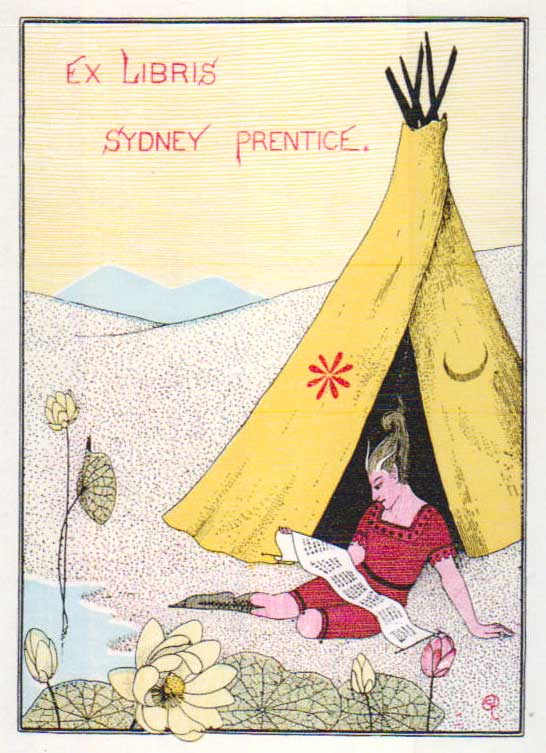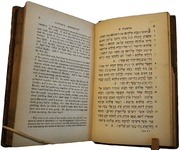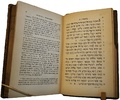For more information on collecting bookplates and an incredible array of beautiful images, visit Jaffe’s Bookplate Junkie blog.

Bookplate mania peaked in America and England from 1890 to about 1920. That’s when the really great collections were formed. Most of these were eventually either dispersed or absorbed into other collections. These collections are like old friends because they all came from the same gene pool: There were around 100 collectors who actively exchanged duplicates and many of the same core plates are to be found in all the collections, and they were typically mounted on 6-inch by 9-inch card stock. Today, if there are even 200 bookplate collectors in the United States I would be very surprised.
Finding Bookplates
When I started this adventure about 35 years ago there was no eBay so I built my collection without it. Today eBay offers an excellent way to find bookplates from around the world. It takes time and discipline because there is so much clutter, but it is still worth the effort.

Top: One of Jaffe’s custom bookplates designed by Daniel Mitsui. Above: A bookplate for Elbert Hubbard, founder of the Roycroft community, created by Raymond Nott.
Bookplate societies are another great resource. When I first got interested in bookplates I joined both The American Society of Bookplate Designers and Collectors and the British Bookplate Society. These organizations gave me an opportunity to meet with and obtain bookplates from other collectors. It still makes good sense to join these organizations, as one of the easiest ways to build a collection is to exchange duplicates. There are over 200 individual members in the group and around three quarters have indicated a willingness to exchange bookplates.
Bookplate engravers and designers are often willing to send you a bookplate in exchange for one of yours. It’s a simple way for them to meet potential customers. Of course, you need a decent bookplate to begin with.
Antiquarian and used booksellers will go out of their way to help you if you make your interest known to them. It gets harder each year as the number of open shops decreases, and the number of pre-1920’s books on their shelves decreases. Start looking in either the poetry or foreign language sections as owners of such books seem to have used bookplates more frequently and there is often less turnover of inventory. Ask the bookseller if they keep a box of detached boards. I have found some excellent 18th century plates in such boxes.
In most large communities there is also at least one hand bookbinder. Check the Yellow Pages, Google, or ask a book dealer. More often than not they are pack rats and hold onto old bookplates, and in some instances are more than willing to sell you a cigar box full. I also buy a number of bookplates directly from dealers at book and paper shows. Once you become a regular face at these shows, dealers will save things for you. It pays to stop at every booth and ask.
I am almost embarrassed to admit that I used to look up the ages of bookplate collectors and write to all those over eighty to inquire if they knew of any collections for sale. It was actually very productive and I bought two major collections that way. For the record, I am 70, so do not bother me until 2018! I’ve occasionally gotten some remarkable bookplates by writing to celebrities, but I have not had much luck in recent years. Too much mail is filtered by assistants and, more often than not, you get a signed photo or an auto-penned label.
Themes in Bookplate Collecting

A design for Sydney Prentice featuring a teepee.
Many collectors have specialized topics and themes that they focus on. I tend to spend my time and energy searching for 18th-century American Ex Libris, bookplates from the libraries of famous people from any country, and bookplates with Jewish signs or symbols. But the list keeps growing. Rabbits are a good case in point: I started with two Rabbit plates and in the dark of night between the covers of their snug album pages they reproduced, so now I have a litter of eight. Five are domestic and three came from England. I know there are collectors out there who focus on dogs, cats, owls, stamps, chess, and even chickens.
I’ve always been partial to dated bookplates. Somehow, knowing precisely when a bookplate was engraved is very orderly and comforting. A strange choice of words perhaps, but that is my gut feeling.
Two excellent reference books about dated bookplates are:
Dated Book-Plates (Ex Libris) with A Treatise On Their Origin And Development by Walter Hamilton. (Three volumes, with Volume two covering the eighteenth century.)
Early Printed Book Labels by Brian North Lee. (Anything written by Brian North Lee is carefully and lovingly researched.)
How to Remove a Bookplate
Let us assume you purchased a book with significant historical significance, an association copy from the library of a president. It would be a crime against future generations to remove the bookplate. On the other hand, if you went to a library book sale and got a Reader’s Digest Condensed Book with a bookplate you wanted, the removal would be completely acceptable. It’s all very subjective.
Over the years I have removed many bookplates. Sometimes the books were donated to a charity, sometimes they were resold on eBay. If you want to learn how to safely remove a bookplate, I would suggest that you start by practicing on distressed items. Those with red dye should be tested first with a moistened Q-Tip, as red ink tends to bleed. From time to time you may be surprised to find a second bookplate under the one you removed.

An Art Deco design for Carleton Noyes.
Here’s how I remove the bookplates without damaging the book:
1. Boil Water.
2. Fold a paper towel in quarters and cut it slightly larger than the bookplate.
3. Using tongs, immerse the folded towel into the boiling water.
4. Place the steaming towel on top of the bookplate. If the bookplate is on the inside front cover be sure it is level. You may have to place a saucer under it to keep it level.
5. Wait two minutes and place the point of a knife under a corner of the bookplate. Lift gently and try to pull off. If you encounter resistance continue to soak another minute.
6. To avoid curling, after removal , place the bookplate between some dry paper towels, place a book on top, and let it sit for a day.
These instructions should not be used for leather bookplates, which were used by many of the wealthiest American bibliophiles in the late 19th and early 20th centuries. They are very elegant, but as a practical matter the oils in the leather tend to damage the pages they touch. Removal of leather bookplates can be done by inserting the tip of an X-acto blade under a corner and gently prying the plate upward. Most glue used on leather did not bond well and the plates usually can be removed intact.
For more information on bookplates visit Lew’s Bookplate Junkie blog.

 Naughty Nuns, Flatulent Monks, and Other Surprises of Sacred Medieval Manuscripts
Naughty Nuns, Flatulent Monks, and Other Surprises of Sacred Medieval Manuscripts
 To Catch A Thief: A Rare Book Expert on His Literary Obsessions
To Catch A Thief: A Rare Book Expert on His Literary Obsessions Naughty Nuns, Flatulent Monks, and Other Surprises of Sacred Medieval Manuscripts
Naughty Nuns, Flatulent Monks, and Other Surprises of Sacred Medieval Manuscripts From Donation Bin to Sotheby's: How a Rare 19th-Century Bible Almost Got Away
From Donation Bin to Sotheby's: How a Rare 19th-Century Bible Almost Got Away BookplatesBookplates, also known by the term ex-libris, evolved over centuries from s…
BookplatesBookplates, also known by the term ex-libris, evolved over centuries from s… Mari Tepper: Laying it on the Line
Mari Tepper: Laying it on the Line Nice Ice: Valerie Hammond on the Genteel Charm of Vintage Canadian Costume Jewelry
Nice Ice: Valerie Hammond on the Genteel Charm of Vintage Canadian Costume Jewelry How Jim Heimann Got Crazy for California Architecture
How Jim Heimann Got Crazy for California Architecture Modernist Man: Jock Peters May Be the Most Influential Architect You've Never Heard Of
Modernist Man: Jock Peters May Be the Most Influential Architect You've Never Heard Of Meet Cute: Were Kokeshi Dolls the Models for Hello Kitty, Pokemon, and Be@rbrick?
Meet Cute: Were Kokeshi Dolls the Models for Hello Kitty, Pokemon, and Be@rbrick? When the King of Comedy Posters Set His Surreal Sights on the World of Rock 'n' Roll
When the King of Comedy Posters Set His Surreal Sights on the World of Rock 'n' Roll How One Artist Makes New Art From Old Coloring Books and Found Photos
How One Artist Makes New Art From Old Coloring Books and Found Photos Say Cheese! How Bad Photography Has Changed Our Definition of Good Pictures
Say Cheese! How Bad Photography Has Changed Our Definition of Good Pictures Middle Earthenware: One Family's Quest to Reclaim Its Place in British Pottery History
Middle Earthenware: One Family's Quest to Reclaim Its Place in British Pottery History Fancy Fowl: How an Evil Sea Captain and a Beloved Queen Made the World Crave KFC
Fancy Fowl: How an Evil Sea Captain and a Beloved Queen Made the World Crave KFC
I use Windex for removing bookplates, very possibly my own discovery!
I spray a fair amount of Windex onto the bookplate and about 1 cm around it, allowing a small “puddle” to form. I let it sit for a 10-20 seconds, then carefully lift a corner with a very thin knife or box-cutter. If there is resistence, I let it sit for another minute or two.
On rare occaisions the windex can cause the ink to run, but of 100s I’ve used, it may have happened once or twice.
If the pbacking paper of the book is chrome paper, there could be problems. The softer and pulpier the paper, the easier it is. Windex dries very fast, and dosen’t do much damage to the book, if at all.
upon removing the plate, I wipe off the melted glue on the back of the plate with liberal Windex sprays.
I often wash the bookplate off under running water, then dry it using your method to prevent curling.
This method does not work on rubber-cememt type glue so-often used today.
I have also experimented with 3-M Office machine cleaning spray, wich is a foam. It often works on stubborn plates, but is stronger and harsher than Windex. the likelyhood of causing ink running is greater.
Yosef
Hello..could someone explain to me exactly what a bookplate is..I’m finding this an interesting collector field but I not not familar with bookplates. Any information would be helpful and much thanks for your time. Best regards, Libby
I have recently found my bookplate collection from the 1970s. I was 8 at the time and I had placed them on construction paper. I have steamed them off now but how can I attractively and safely store them?
Thanks!
I have recently purchased a hand-made leather blank journal with an oriental motif of dragons on front/verso. The acid-free pages are hand-made also. I had planned on tipping-in each bookplate per page. Book has 200 pages. This also leaves space on the page for writing important facts regarding each bookplate. The journal has antique “C-locks” to enclose the contents within its designed leather covers. Tipping them in requires the kind of light glue, available at “hobby” shops which adheres just along the edge like a “post-it” note. I would not recommend adhering bookplates to cardboard or using a harsh glue even to mount them on paper.
I’m interested in starting a bookplate collection. I have 5 beautiful plates
that I have framed and am looking for more. I will follow your advice
about pre-1920’s books and hope for success. Thanks for the info..
Could any of you advise on the type of glue to use to glue a personal bookplate on your books. One that would not ruin the paper of the plate and book. Thanks.
Greetings! Thank you for the space n opportunity to connect w/ fellow bookplate enthusiasts. Altho my interest dates back many years, this is the first time I am actually getting involved, iif only to search places-printers,sellers,outlets in general-who are in the business market,catering to those,such as myself,for personal use. In time, I am certain,this need will evolve into the more serious phase,that of immersion in the history of Bookplates,then collecting. I would like to think that one needs to prepare,before the hunt. Nowjust as I learned from serious collector of the rich age of 70,at the time his commentaries were published here, search anywhere,everywhere-a true example of due diligence. I intend to do so,exactly. During my handful of searches, it generated multiple sites w/offerings,but none of which handles the specific item I want: bookplate w/Japanese themes. Various subjects,such as the four elements, the medieval Japan,in general. One item of extreme interest- the Samurai and its feudal culture, which were heavily recorded in paintings, woodblocks,etc. So,I do have more than a handful,but nowhere to go..I will be checking in sometime again..,see if anyone picks up on my commentaries. Meanwhile, I really have to do better w/mhy searches. I have compiled a small library of some 40-50books in a three month period. And I want to keep them neat and lasting,this time. Kind regards to all. Sincerely,Rr
Hi, Lew Jaffe,
I enjoyed your article, even if it’s several years old. Do you still collect?
I am a collector since my teenage years and now I’m a sernior citizen. I LOVE my collection! Most of my pieces are from Europe. I have signed, embossed and unsigned pieces.
Who could appraise my collection? I found that most people are not familiar with ex libris and small grafics collections, ergo, they don’t know how to price them. When I pass away, I don’t want my collection end up unappreciated because the appraisor of my earthly posessions is uninformed.
I’ll appreciate your help.
Marta